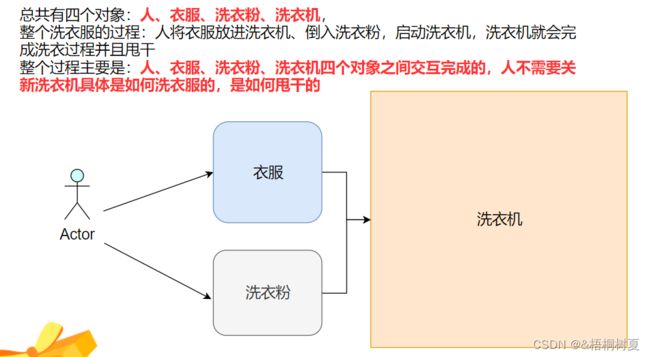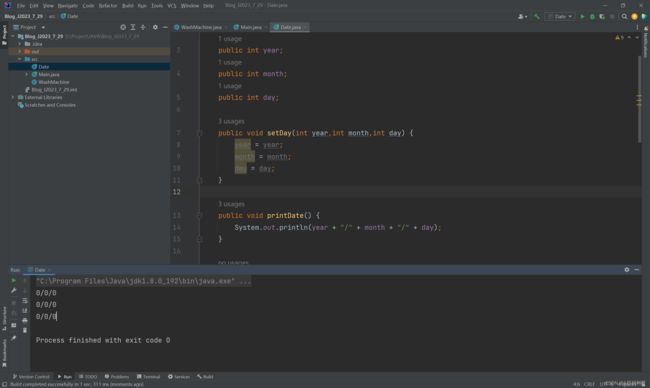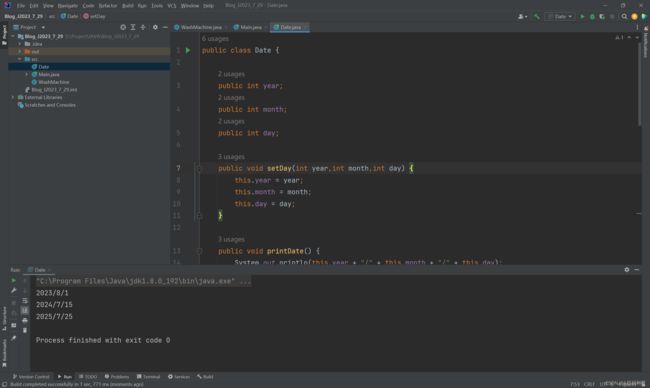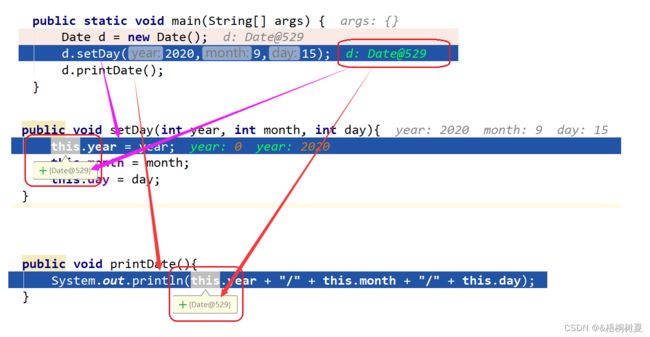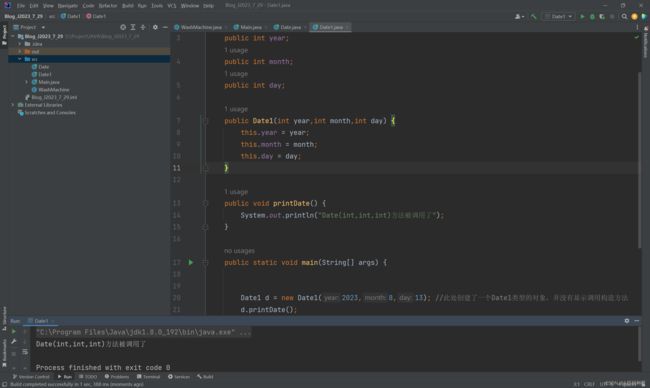JavaSE 类和对象
Java SE 类与对象
1. 面向对象的初步认识
1.1 什么是面向对象
面向对象是解决问题的一种思想,主要依靠对象之间的交互完成一件事情。对于Java来说,一切皆对象
1.2 面向对象与面向过程
就拿洗衣服这件事来说,传统的洗衣方式更注重的是洗衣服的过程:
在注重过程的情况下,若衣服需要清洗的程度不同,时间长度,拧干方式不同,处理起来就比较麻烦
若按照这种方式来写代码,将来扩展或者维护起来会比较麻烦
而现代的洗衣方式更注重的是对象之间的交互:
以面向对象的方式来进行处理,就不关注洗衣服的过程,具体洗衣机是怎么洗衣服,如何来甩干衣服的,用户不用去关心,只需要将衣服放进洗衣机,倒入洗衣粉,启动开关即可,通过对象之间的交互来完成。
注:面向对象和面向过程并不是一门语言,而是解决问题的方法,没有好坏之分,都有其专门的应用场景。
2. 类的定义和使用
面向对象程序设计关注的是对象,而对象就是现实生活中的实体,
2.1 简单认识类
类是用来对一个实体(对象)来进行描述的,主要描述该实体(对象)具有哪些属性(外观尺寸等),哪些功能(用来做什么),描述完成后计算机就可以对这个对象进行识别了
比如:洗衣机 在Java中可以将其看成是一个类别
属性:产品品牌,型号,产品重量,外观尺寸,颜色...
功能:洗衣,烘干,定时,脱水...
2.2 类的定义格式
在Java中定义时需要用到class关键字,具体语法如下:
//创建类
class ClassName {
field; //字段(属性) 或 成员变量
method; //行为 或成员方法
}
class为定义类的关键字,ClassName为类的名字,{}中为类的主体。
类中包含的内容称为类的成员。其中,属性主要是用来描述类的,称之为类的成员属性或成员变量。方法主要说明类有哪些功能,称为类的成员方法
代码示例:
public class WashMachine {
public String brand; //品牌
public String type; //型号
public double weight; //重量
public double length;//长度
public double width; //宽度
public double height; //高度
public String color; //颜色
public void washClothes() { //洗衣
System.out.println("洗衣功能");
}
public void dryClothes() { //脱水
System.out.println("脱水功能");
}
}
采用Java语言将洗衣机类在计算机中定义完成,结果javac编译之后形成.class文件,在JVM的基础上计算机就可以识别了。
注:
-
类名采用大驼峰定义
-
一般一个文件当中只定义一个类
-
main方法所在的类一般要使用public修饰
-
public修饰的类必须要和文件名相同
3. 类的实例化
3.1 什么是实例化
定义了一个类,就相当于在计算机中定义了一种新的类型,与int,double类似,只不过int和double是Java语言自带的内置类型,而类是用户自定义了一个新的类型。
用类类型创建对象的过程,称为类的实例化
在java中采用new关键字配合类名来实例化对象。
类名 引用变量名 = new 类名();
代码示例:
class PetDog {
//狗的属性
public String name;
public String color;
//狗的行为
public void barks() {
System.out.println(this.name + "旺旺叫");
}
public void wag() {
System.out.println(this.name + "摇尾巴");
}
}
public class Main {
public static void main(String[] args) {
PetDog petDog1 = new PetDog();
PetDog petDog2 = new PetDog();
petDog1.name = "阿黄";
petDog1.color = "黄色";
petDog1.barks();
petDog1.wag();
System.out.println("============");
petDog2.name = "赛虎";
petDog2.color = "棕色";
petDog2.barks();
petDog2.wag();
}
}
//执行结果
阿黄旺旺叫
阿黄摇尾巴
============
赛虎旺旺叫
赛虎摇尾巴
注:
- new关键字用于创建一个对象的实例
- 使用
.来访问对象中的属性和方法 - 同一个类可以创建多个对象
3.2 类和对象说明
- 类只是一个模型一样的东西,用来对一个实体进行描述,限定了类有哪些成员
- 类是一种自定义的类型,可以用来定义变量
- 一个类可以实例化出多个对象,但只有被实例化出的对象才能占用实际的物理空间,存储类成员变量
4. this引用
4.1 为什么要有this引用
先看这段代码:
public class Date {
public int year;
public int month;
public int day;
public void setDay(int year,int month,int day) {
year = year;
month = month;
day = day;
}
public void printDate() {
System.out.println(year + "/" + month + "/" + day);
}
public static void main(String[] args) {
//构建三个日期类型的对象
Date d1 = new Date();
Date d2 = new Date();
Date d3 = new Date();
//对三个对象进行日期设置
d1.setDay(2023,8,1);
d2.setDay(2024,7,15);
d3.setDay(2025,7,25);
//打印日期对象中的内容
d1.printDate();
d2.printDate();
d3.printDate();
}
}
//执行结果
0/0/0
0/0/0
0/0/0
以上代码定义了一个日期类,然后main方法中创建了三个对象,并通过Date类中的成员方法对对象进行设置和打印,代码整体逻辑非常简单,看着没有任何问题,可结果为什么会出问题呢?
一切和下面这段代码脱不了关系:
public void setDay(int year,int month,int day) {
year = year;
month = month;
day = day;
}
在这段代码里,函数体中到底是谁在给谁赋值?成员变量给成员变量?参数给参数?参数给成员变量?看似已经出现了分歧,并且setDate和printDate函数又是如何知道打印的是哪个对象的数据呢?
如何解决这些问题,这时就轮到我们this引用出场了!
4.2 什么是this引用
this引用指向当前对象(成员方法运行时调用该成员方法的对象),在成员方法中所有成员变量的操作,都是通过该引用去访问。只不过所有的操作对用户是透明的,即用户不需要传递,编译器自动完成。
代码示例:
public class Date {
public int year;
public int month;
public int day;
public void setDay(int year,int month,int day) {
this.year = year; //这里使用了this引用
this.month = month;
this.day = day;
}
public void printDate() {
System.out.println(this.year + "/" + this.month + "/" + this.day);
}
public static void main(String[] args) {
//构建三个日期类型的对象
Date d1 = new Date();
Date d2 = new Date();
Date d3 = new Date();
//对三个对象进行日期设置
d1.setDay(2023,8,1);
d2.setDay(2024,7,15);
d3.setDay(2025,7,25);
//打印日期对象中的内容
d1.printDate();
d2.printDate();
d3.printDate();
}
}
//执行结果
2023/8/1
2024/7/15
2025/7/25
注:this引用的是调用成员方法的对象
public static void main(String[] args) {
Date d = new Date();
d.setDay(2020,9,15);
d.printDate();
}
4.3 this引用的特性
- this的类型:对于类类型引用,即哪个对象调用就是哪个对象的引用类型
- this只能在"成员方法"中使用
- 在"成员方法"中,this只能引用当前对象,不能在引用其他对象
- this是"成员方法"第一个隐藏的参数,编译器会自动传递,在成员方法执行时,编译器会赋值将调用成员方法对象的引用传递给该成员方法,this负责来接收
5. 对象的构造及初始化
5.1 构造方法
5.1.1 概念
构造方法(也称构造器)是一个特殊的成员方法,名字必须与类名相同,在创建对象时,由编译器自动调用,并且在整个对象的生命周期内只调用一次
代码示例:
public class Date1 {
public int year;
public int month;
public int day;
public Date1(int year,int month,int day) {
this.year = year;
this.month = month;
this.day = day;
}
public void printDate() {
System.out.println("Date(int,int,int)方法被调用了");
}
public static void main(String[] args) {
Date1 d = new Date1(2023,8,13); //此处创建了一个Date1类型的对象,并没有显示调用构造方法
d.printDate();
}
}
//执行结果
Date(int,int,int)方法被调用了
注:构造方法的作用就是对对象中的成员进行初始化,并不负责给对象开辟空间
5.2.2 特性
- 构造方法名必须与类名相同
- 没有返回值类型,设置void也不行
- 创建对象时由编译器自动调用,并且在对象的生命周期内只调用一次
- 构造方法可以重载(用户根据自己的需求提供不同参数的构造方法)
代码示例:
public class Date2 {
public int year;
public int month;
public int day;
public Date2() {
this.year = 2020;
this.month = 7;
this.day = 25;
}
public Date2(int year,int month,int day) {
this.year = year;
this.month = month;
this.day = day;
}
public void printDate() {
System.out.println(this.year + "/" + this.month + "/" + this.day);
}
public static void main(String[] args) {
Date2 d = new Date2();
d.printDate();
}
}
//执行结果
2020/7/25
注:因为上述两个构造方法名字相同,参数列表不同,因此构成了方法重载
- 如果用户没有显示定义,编译器会生成一份默认的构造方法,生成的默认构造方法一定是无参的
public class Date2 {
public int year;
public int month;
public int day;
public void printDate() {
System.out.println(this.year + "/" + this.month + "/" + this.day);
}
public static void main(String[] args) {
Date2 d = new Date2();
d.printDate();
}
}
//执行结果
0/0/0
注:一旦用户定义,编译器则不会自动生成构造方法
- 构造方法中,可以通过this调用其他构造方法来简化代码
public class Date3 {
public int year;
public int month;
public int day;
//无参构造方法-内部给各个成员赋初始值,该部分功能与三个参数的构造方法重复
//可以在无参构造方法中通过this调用带有三个参数的构造方法,但this(1900,1,1)必须是构造方法中第一条语句
public Date3() {
this(1900,1,1);
}
//带有三个参数的构造方法
public Date3(int year,int month,int day) {
this.year = year;
this.month = month;
this.day = day;
}
}
注:
-
this()必须是构造方法中第一条语句
-
不能形成环
public Date3() { this(1900,1,1); } public Date3(int year,int month,int day) { this(); } //会报错
- 绝大多数情况下使用public来修饰,特殊场景下会用private修饰
5.2 成员变量初始化特点
在Java方法内部定义一个局部变量是,必须要初始化,否则会编译失败,但成员变量可以不用初始化也能使用
原因:在对象空间被申请好后,对象中包含的成员已经设置好了初始值
| 数据类型 | 默认值 |
|---|---|
| byte | 0 |
| char | ‘\u0000’ |
| short | 0 |
| int | 0 |
| long | 0L |
| boolean | false |
| float | 0.0f |
| double | 0.0 |
| reference | null |
5.3 就地初始化
在声明成员变量时,直接给出初始值
代码示例:
public class Date4 {
public int year = 1922;
public int month = 7;
public int day = 25;
public Date4() {
}
public Date4(int year,int month,int day) {
}
public void printDate() {
System.out.println(this.year + "/" + this.month + "/" + this.day);
}
public static void main(String[] args) {
Date4 d1 = new Date4(2022,6,7);//在这里传入的参数没有被使用到
Date4 d2 = new Date4();
d1.printDate();
d2.printDate();
}
}
//执行结果
1922/7/25
1922/7/25
注:代码编译完成后,编译器会将所有给成员初始化的这些语句添加到各个构造函数中

